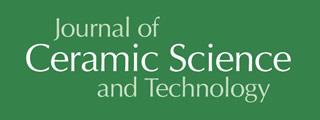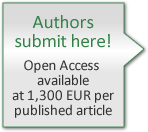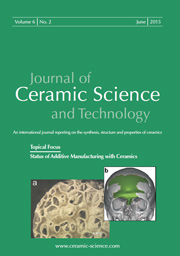Articles
All articles | Recent articles
Oxidative Crack Healing in Al2O3 Composites Loaded with Ti2AC (A = Al, Sn) Repair Fillers
B.J. Pedimonte, G. Bei, D. Pourjafar, T. Fey, P. Greil
University of Erlangen-Nuernberg, Department of Materials Science (Glass and Ceramics) Martensstr. 5, 91058 Erlangen, Germany
received December 03, 2013, received in revised form January 15, 2014, accepted February 04, 2014
Vol. 5, No. 1, Pages 63-68 DOI: 10.4416/JCST2013-00044
Abstract
Crack healing of alumina composites loaded with 5, 10, and 20 vol% Ti2AC (A = Al or Sn) MAX phase was investigated. Surface cracks were prepared by means of indent loading and the modulus of rupture was measured on virgin, indented, and healed specimens. The MAX phase particles serve as repair filler which reacts with oxygen penetrating along a surface crack and filling disrupted crack surfaces with the oxidation reaction products. After annealing for 3 h composites loaded with 20 vol% Ti2AlC showed full recovery at a healing temperature of approximately 900 °C, whereas lower temperatures of 700 °C were observed for specimens loaded with 10 and 20 vol% Ti2SnC. The enhanced healing response of Ti2AC-loaded composites containing Sn instead of Al on the A-position offers high potential for providing crack healing capability to ceramic matrix composites applied at moderate temperatures below 1000 °C.
![]() Download Full Article (PDF)
Download Full Article (PDF)
Keywords
MAX phase composites, crack healing, repair filler, alumina, oxidation
References
1 Hager, M.D., Greil, P., Leyens, C., Van Der Zwaag, S., Schubert, U.S.: Self-healing materials, Adv. Mater., 22, 5424 – 5430, (2010).
2 Greil, P.: Generic principles of crack-healing ceramics, J. Adv. Ceram., 1, 249 – 267, (2012).
3 Gupta, T.K.: Crack healing and strengthening of thermally shocked alumina, J. Am. Ceram. Soc., 59, 259 – 262, (1976).
4 Thompson, A.M., Chan, H.M., Harmer, M.P., Cook, R.F.: Crack healing and stress relaxation in Al2O3-SiC nanocomposites, J. Am. Ceram. Soc., 78, 567 – 571, (1995).
5 Takahashi, K., Yokouchi, M., Lee, S.K., Ando, K.: Crack-healing behavior of Al2O3 toughened by SiC whiskers, J. Am. Ceram. Soc., 86, 2143 – 2147, (2003).
6 Nakao, W., Ono, M., Lee, S.K., Takahashi, K., Ando, K.: Critical crack-healing condition for SiC whisker reinforced alumina under stress, J. Eur. Ceram. Soc., 25, 3649 – 3655, (2005).
7 Nakao, W., Abe, S.: Enhancement of the self-healing ability in oxidation induced self-healing ceramic by modifying the healing agent, Smart Mater. Struct., 21, 025002, (2012).
8 Barsoum, M.W.: The MN+1AXN phases: A new class of solids thermodynamically stable nanolaminates, Prog. Solid State Chem., 28, 201 – 281, (2000).
9 Wang, X.H., Zhou, Y.C.: Layered machinable and electrically conductive Ti2AlC and Ti3AlC2 ceramics: A review, J. Mater. Sci. Tech., 26, 385 – 416, (2010).
10 Song, G.M., Pei, Y.T., Sloof, W.G., Li, S.B., De Hosson, J.T.M., van der Zwaag, S.: Oxidation-induced crack healing in Ti3AlC2 ceramics, Scripta Mater., 58, 13 – 16, (2008).
11 Li, S., Song, G., Kwakernaak, K., van der Zwaag, S., Sloof, W.G.: Multiple crack healing of a Ti2AlC ceramic, J. Eur. Ceram. Soc., 32, 1813 – 1820, (2012).
12 Li, S., Xiao, L., Song, G., Wu, X., Sloof, W.G., Van der Zwaag, S.: Oxidation and crack healing behavior of a fine-grained Cr2AlC ceramic, J. Am. Ceram. Soc., 96, 892 – 899, (2013).
13 Bei, G., Pedimonte, B.J., Fey, T., Greil, P.: Oxidation behavior of MAX phase Ti2Al(1-x)SnxC solid solution, J. Am. Ceram. Soc., 96, 1359 – 1362, (2013).
14 Green, D.J.: An introduction to the mechanical properties of ceramics, Cambridge University Press, UK, (1998).
15 Li, S.B., Bei, G.P., Zhai, H.X., Zhou, Y.: Bimodal microstructure and reaction mechanism of Ti2SnC synthesized by a high-temperature reaction using Ti/Sn/C and Ti/Sn/TiC powder compacts, J. Am. Ceram. Soc., 89, 3617 – 3623, (2006).
16 Rahaman, M.N.: Ceramic processing and sintering, 2nd edition, Marcel Dekker Inc., NY, (2003).
17 Hogg, R.: Mixing and segregation in powders: Evaluation, mechanisms and processes, KONA Powder Part. J., 27, 3 – 17, (2009).
18 Ohji, T., Jeong, Y.K., Choa, Y.H., Niihara, K.: Strengthening and toughening mechanisms of ceramic nanocomposites, J. Am. Ceram. Soc., 81, 1453 – 1460, (1998).
19 Van der Zwaag, S., Van Dijk, N.H., Jonkers, H.M., Mookhoek, S.D., Sloof, W.G.: Self-healing behaviour in man-made engineering materials: Bioinspired but taking into account their intrinsic character, Phil. Trans., 367, 1689 – 1704, (2009).
20 Osada, T., Nakao, W., Takahashi, K., Ando, K.: Kinetics of self-crack-healing of alumina/Silicon carbide composite including oxygen partial pressure effect, J. Am. Ceram. Soc., 92, 864 – 869, (2009).
21 Liu, B., Wang, J.Y., Zhang, J., Li, F.Z., Zhou, Y.C.: Theoretical investigation of A-element atom diffusion in Ti2AC (A = Sn, Ga, Cd, In, and Pb), Appl. Phys. Lett., 94, 181906, (2009).
22 Song, G.M., Schnabel, V., Kwakernaak, C., van der Zwaag, S., Schneider, J.M., Sloof, W.G.: High temperature oxidation behaviour of Ti2AlC ceramic at 1200 °C, Mater. High Temp., 29, 205 – 209, (2012).
Copyright
Göller Verlag GmbH


